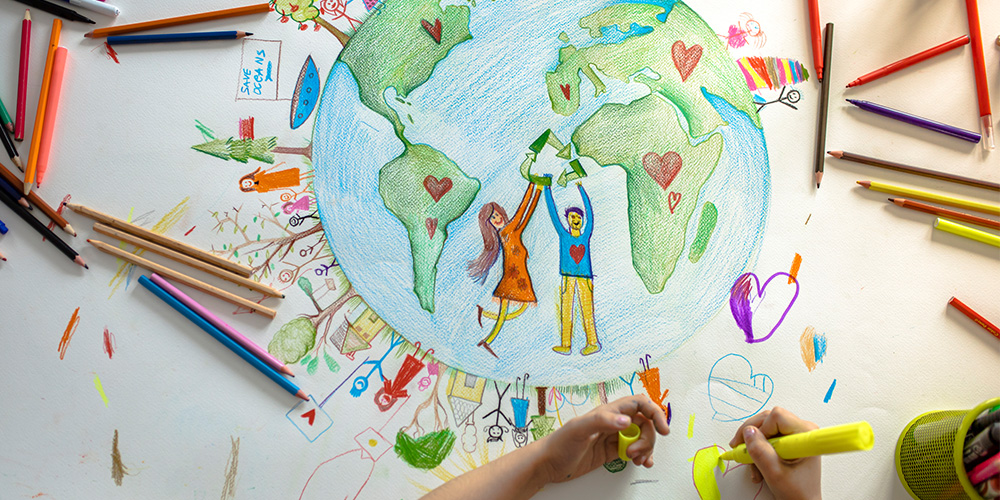The climate is changing. As NASA reports, “Glaciers have shrunk, ice on rivers and lakes is breaking up earlier, plant and animal ranges have shifted and trees are flowering sooner.” If global temperatures continue to increase over time, scientists and researchers are concerned about the uneven long-term impacts in different areas around the world. For example, while growing seasons are lengthening in the United States, some projections show that droughts and heat waves will increase in some areas, hurricanes may become more intense and frequent, and flooding and land subsidence will increase along the coasts as sea levels rise.
Perhaps unsurprisingly, Generation Z (those born in the late 1990s through the early 2010s) is the most climate-conscious generation on the planet right now. According to CNBC, “4 out of 10 young people identified climate change as one of the most significant issues facing the planet. Gen Z is uniquely positioned in part because, for many, they cannot recall a time when climate change was not a topic of discussion.”
Here are some activities to help the Gen Zers in your classroom understand important concepts in climate and conservation efforts.
Make S’Mores With a Solar Oven!
Grades: Elementary
Price: Free
Materials required: Cardboard box, aluminum foil, clear plastic wrap, glue stick, tape, stick, ruler, box cutter, aluminum pie pan, s’mores ingredients
Your students might have heard the term greenhouse effect, but do they really understand it? A solar oven is one way to teach your students about the way gasses in the Earth’s atmosphere can “trap” the sun’s heat, thus raising the Earth’s temperature.
This activity gives you step-by-step instructions on how to create a solar oven using common household items, including a cardboard box, aluminum foil, and plastic wrap. Plus, give your students a sweet treat by showing them how your solar oven can cook a s’more!
What’s Causing Sea-Level Rise? Land Ice vs. Sea Ice
Grades: 2–8
Price: Free
Materials required: Two clear plastic food-storage containers, clay, ice cubes, ruler, water, permanent marker
Rising sea levels and melting glaciers are climate change issues we hear about a lot. But did you know that melting land glaciers actually contribute to rising water levels more than melting sea glaciers? This activity from NASA will teach your students why!
Using clay to represent land and tap water to represent the sea, you’ll allow “glaciers” (i.e., ice cubes) to melt throughout the school day. In one container, you’ll place ice cubes on the clay and in the other, you’ll place them in water. Then you’ll measure the impact on water levels in the two different containers. The activity provides detailed instructions as well as discussion questions and an assessment.
Save Our Earth! Alternative Uses for Common Trash
Grades: 5–8
Price: Free with TeacherVision starter account
Materials required: Varies
According to Conservation.org, we dump a staggering 17.6 billion pounds of plastic into the ocean each year. At that rate, plastic will outweigh fish in the ocean by 2050. And the worst part is, some of the most common trash items in the ocean could be reused or disposed of properly to prevent this waste.
This activity from TeacherVision shows your students the most common garbage people find washed up on the beach and challenges them to think of alternative uses for these items. It also includes instructions for hosting a cleanup day at your school and helping students think through how they can promote recycling in their community.
Science, Technology, and Society: Making New Soil From Garbage Printable
Grades: 2–4
Price: Free with TeacherVision starter account
Materials required: None
Recycling can take many forms, and composting is one of the most useful. Composting takes organic materials that would otherwise end up in a landfill (e.g., egg shells, coffee grounds, fruit rinds) and turns them into healthy soil. This guided worksheet teaches students the kinds of materials that are good for composting and helps them make a plan for how to introduce composting practices in their home and community.
Climate vs. Weather Notes, Application, and Sorting Activity
Grades: 5–9
Price: $2.50
Materials required: None
Weather is a huge part of climate, but the two terms are far from interchangeable. This simple, focused Teachers Pay Teachers activity provides guided notes and two different sorting activities that give your students practice identifying whether a given scenario represents a weather phenomenon or climate phenomenon.






